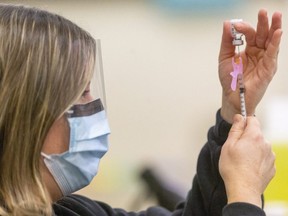COVID-19 vaccination campaigns may not be the big news they were during the pandemic, but, to remind us the virus will be with us always, the Middlesex-London Health Unit is ramping up for a springtime targeted booster blitz for the most vulnerable.
Health
Sims: COVID isn’t in the rear-view mirror, much as we would like it to be

|
|
COVID-19 vaccination campaigns may not be the big news they were during the pandemic, but, to remind us the virus will be with us always, the Middlesex-London health unit is ramping up for a springtime targeted booster blitz for the most vulnerable.
The anniversary of the start of the global pandemic was Saturday. It was March 11, 2020, when the World Health Organization (WHO) declared its deep concern about the virus after announcing there were 118,000 cases of COVID-19 in more than 114 countries and 4,291 deaths.
Middlesex-London has had 48,725 reported cases and 527 deaths.
“Fortunately, the baseline immunity in the population from an amazing vaccination effort and previous infection is such that the severity is no longer overwhelming our health care system and not leading to the same amount of deaths and severe hospitalizations that it was,” Summers said.
That is how we should be thinking about COVID-19 in 2023. Summers expects this fall there will be recommended annual booster doses for COVID-19 and the flu. We should expect public health messages about the importance of hand washing and staying home if ill, messages that were drilled into the community’s consciousness during the pandemic.
“Hopefully, the memories of the last three years emphasize the importance of ongoing public health principles, year in and year out,” Summers said.
There are reasons to use this anniversary as a moment to celebrate our resilience and ingenuity to push back against the spread of the disease and return to more normal lives.
The health unit said that more than 1.35 million doses were given through its mass vaccination clinics, pop-up clinics at local malls, community-based clinics at schools and community centres, through the provincial government’s Go-VAXX bus and at pharmacies and health care provider offices.
“The goal was always, you know, certainly for us in public health, to protect the lives and the health of our population and that also includes the quality of life,” Summers said. “We want people be able to socialize, we want people to be able to go to concerts and go to dinners and to travel and to do those things. The objective is making life what people want their lives to be.”
That means a renewed commitment to all vaccinations, to science, to infection prevention and control, and to limiting the spread of misinformation “so that we are confident in the scientific evidence we have to protect ourselves,” Summers said.
“These types of commitments will allow for people, hopefully, to continue to live those lives that we want people to live and that they wish to live,” he said.
It’s a relief to move past the days when COVID-19 brought society to a standstill, but Summers hopes the community doesn’t forget because “that informs their commitment to these public health principles moving forward.”
Summers said any emergence of new variants, the effectiveness of the vaccine and if we can sustain immunity against the virus could change how we deal with the illness.
But now, the community knows how to push back.
“I think one of the messages I try to (reiterate) for folks is that there’s tools available to you. You’ve got to understand your risks and COVID is never going to go away. So, you’ve got to make some decisions about how you’re going to approach this now,” Summers said.





Health
RCMP warn about benzodiazepine-laced fentanyl tied to overdose in Alberta – Edmonton Journal


Article content
Grande Prairie RCMP issued a warning Friday after it was revealed fentanyl linked to a deadly overdose was mixed with a chemical that doesn’t respond to naloxone treatment.
The drugs were initially seized on Feb. 28 after a fatal overdose, and this week, Health Canada reported back to Mounties that the fentanyl had been mixed with Bromazolam, which is a benzodiazepine.
Article content
Mounties say this is the first recorded instance of Bromazolam in Alberta. The drug has previously been linked to nine fatal overdoses in New Brunswick in 2022.
The pills seized in Alberta were oval-shaped and stamped with “20” and “SS,” though Mounties say it can come in other forms.
Naloxone treatment, given in many cases of opioid toxicity, is not effective in reversing the effects of Bromazalam, Mounties said, and therefore, any fentanyl mixed with the benzodiazepine “would see a reduced effectiveness of naloxone, requiring the use of additional doses and may still result in a fatality.”
From January to November of last year, there were 1,706 opioid-related deaths in Alberta, and 57 linked to benzodiazepine, up from 1,375 and 43, respectively, in 2022.
Mounties say officers responded to about 1,100 opioid-related calls for service, last year with a third of those proving fatal. RCMP officers also used naloxone 67 times while in the field, a jump of nearly a third over the previous year.
Recommended from Editorial
Share this article in your social network
Health
CFIA continues surveillance for HPAI in cattle, while sticking with original name for disease – RealAgriculture


The Canada Food Inspection Agency will continue to refer to highly pathogenic avian influenza in cattle as HPAI in cattle, and not refer to it as bovine influenza A virus (BIAV), as suggested by the American Association of Bovine Practitioners earlier this month.
Dr. Martin Appelt, senior director for the Canadian Food Inspection Agency, in the interview below, says at this time Canada will stick with “HPAI in cattle” when referencing the disease that’s been confirmed in dairy cattle in multiple states in the U.S.
The CFIA’s naming policy is consistent with the agency’s U.S. counterparts’, as the U.S. Animal and Plant Health Inspection Service has also said it will continue referring to it as HPAI or H5N1.
Appelt explains how the CFIA is learning from the U.S. experience to-date, and how it is working with veterinarians across Canada to stay vigilant for signs of the disease in dairy and beef cattle.
As of April 19, there has not been a confirmed case of HPAI in cattle in Canada. Appelt says it’s too soon to say if an eventual positive case will significantly restrict animal movement, as is the case with positive poultry cases.
This is a major concern for the cattle industry, as beef cattle especially move north and south across the U.S. border by the thousands. Appelt says that CFIA will address an infection in each species differently in conjunction with how the disease is spread and the threat to neighbouring farms or livestock.
Currently, provincial dairy organizations have advised producers to postpone any non-essential tours of dairy barns, as a precaution, in addition to other biosecurity measures to reduce the risk of cattle contracting HPAI.
Subscribe: Apple Podcasts | Spotify | RSS | All Podcasts
jQuery(document).ready(function($) {
$(“#homesub”).validate(
rules:
first_name:
required: true,
minlength: 2
,
last_name:
required: true,
minlength: 2
,
email:
required: true,
email: true,
minlength: 2
,
state:
required: true,
,
role:
required: true,
,
“listid[]”:
required: true,
minlength: 1
,
messages:
first_name: “Your first name is required.”,
last_name: “Your last name is required.”,
email: “Please verify your email is correct.”,
state: “Your state/province is required.”,
role: “Your role is required.”,
“listid[]”: “Select at least one list is required.”
,
submitHandler: function()
$.ajax(
type: “POST”,
url: “https://www.realagriculture.com/wp-admin/admin-ajax.php”,
data:
action: “realag_cc_process_subscribe_onclick”,
form: “homesub”,
data: $(“#homesub”).serialize(),
,
dataType: “html”,
timeout: 30000,
error: function(response)
console.log(response);
,
success: function(response)
$(“#homesub”).html(response);
,
);
);
});
Health
Toronto reports 2 more measles cases. Use our tool to check the spread in Canada – Toronto Star


/* OOVVUU Targeting */
const path = ‘/news/canada’;
const siteName = ‘thestar.com’;
let domain = ‘thestar.com’;
if (siteName === ‘thestar.com’)
domain = ‘thestar.com’;
else if (siteName === ‘niagarafallsreview.ca’)
domain = ‘niagara_falls_review’;
else if (siteName === ‘stcatharinesstandard.ca’)
domain = ‘st_catharines_standard’;
else if (siteName === ‘thepeterboroughexaminer.com’)
domain = ‘the_peterborough_examiner’;
else if (siteName === ‘therecord.com’)
domain = ‘the_record’;
else if (siteName === ‘thespec.com’)
domain = ‘the_spec’;
else if (siteName === ‘wellandtribune.ca’)
domain = ‘welland_tribune’;
else if (siteName === ‘bramptonguardian.com’)
domain = ‘brampton_guardian’;
else if (siteName === ‘caledonenterprise.com’)
domain = ‘caledon_enterprise’;
else if (siteName === ‘cambridgetimes.ca’)
domain = ‘cambridge_times’;
else if (siteName === ‘durhamregion.com’)
domain = ‘durham_region’;
else if (siteName === ‘guelphmercury.com’)
domain = ‘guelph_mercury’;
else if (siteName === ‘insidehalton.com’)
domain = ‘inside_halton’;
else if (siteName === ‘insideottawavalley.com’)
domain = ‘inside_ottawa_valley’;
else if (siteName === ‘mississauga.com’)
domain = ‘mississauga’;
else if (siteName === ‘muskokaregion.com’)
domain = ‘muskoka_region’;
else if (siteName === ‘newhamburgindependent.ca’)
domain = ‘new_hamburg_independent’;
else if (siteName === ‘niagarathisweek.com’)
domain = ‘niagara_this_week’;
else if (siteName === ‘northbaynipissing.com’)
domain = ‘north_bay_nipissing’;
else if (siteName === ‘northumberlandnews.com’)
domain = ‘northumberland_news’;
else if (siteName === ‘orangeville.com’)
domain = ‘orangeville’;
else if (siteName === ‘ourwindsor.ca’)
domain = ‘our_windsor’;
else if (siteName === ‘parrysound.com’)
domain = ‘parrysound’;
else if (siteName === ‘simcoe.com’)
domain = ‘simcoe’;
else if (siteName === ‘theifp.ca’)
domain = ‘the_ifp’;
else if (siteName === ‘waterloochronicle.ca’)
domain = ‘waterloo_chronicle’;
else if (siteName === ‘yorkregion.com’)
domain = ‘york_region’;
let sectionTag = ”;
try
if (domain === ‘thestar.com’ && path.indexOf(‘wires/’) = 0)
sectionTag = ‘/business’;
else if (path.indexOf(‘/autos’) >= 0)
sectionTag = ‘/autos’;
else if (path.indexOf(‘/entertainment’) >= 0)
sectionTag = ‘/entertainment’;
else if (path.indexOf(‘/life’) >= 0)
sectionTag = ‘/life’;
else if (path.indexOf(‘/news’) >= 0)
sectionTag = ‘/news’;
else if (path.indexOf(‘/politics’) >= 0)
sectionTag = ‘/politics’;
else if (path.indexOf(‘/sports’) >= 0)
sectionTag = ‘/sports’;
else if (path.indexOf(‘/opinion’) >= 0)
sectionTag = ‘/opinion’;
} catch (ex)
const descriptionUrl = ‘window.location.href’;
const vid = ‘mediainfo.reference_id’;
const cmsId = ‘2665777’;
let url = `https://pubads.g.doubleclick.net/gampad/ads?iu=/58580620/$domain/video/oovvuu$sectionTag&description_url=$descriptionUrl&vid=$vid&cmsid=$cmsId&tfcd=0&npa=0&sz=640×480&ad_rule=0&gdfp_req=1&output=vast&unviewed_position_start=1&env=vp&impl=s&correlator=`;
url = url.split(‘ ‘).join(”);
window.oovvuuReplacementAdServerURL = url;
Canada has seen a concerning rise in measles cases in the first months of 2024.
By the third week of March, the country had already recorded more than three times the number of cases as all of last year. Canada had just 12 cases of measles in 2023, up from three in 2022.
function buildUserSwitchAccountsForm()
var form = document.getElementById(‘user-local-logout-form-switch-accounts’);
if (form) return;
// build form with javascript since having a form element here breaks the payment modal.
var switchForm = document.createElement(‘form’);
switchForm.setAttribute(‘id’,’user-local-logout-form-switch-accounts’);
switchForm.setAttribute(‘method’,’post’);
switchForm.setAttribute(‘action’,’https://www.thestar.com/tncms/auth/logout/?return=https://www.thestar.com/users/login/?referer_url=https%3A%2F%2Fwww.thestar.com%2Fnews%2Fcanada%2Ftoronto-reports-2-more-measles-cases-use-our-tool-to-check-the-spread-in-canada%2Farticle_20aa7df4-e88f-11ee-8fad-8f8368d7ff53.html’);
switchForm.setAttribute(‘style’,’display:none;’);
var refUrl = document.createElement(‘input’); //input element, text
refUrl.setAttribute(‘type’,’hidden’);
refUrl.setAttribute(‘name’,’referer_url’);
refUrl.setAttribute(‘value’,’https://www.thestar.com/news/canada/toronto-reports-2-more-measles-cases-use-our-tool-to-check-the-spread-in-canada/article_20aa7df4-e88f-11ee-8fad-8f8368d7ff53.html’);
var submit = document.createElement(‘input’);
submit.setAttribute(‘type’,’submit’);
submit.setAttribute(‘name’,’logout’);
submit.setAttribute(‘value’,’Logout’);
switchForm.appendChild(refUrl);
switchForm.appendChild(submit);
document.getElementsByTagName(‘body’)[0].appendChild(switchForm);
function handleUserSwitchAccounts()
window.sessionStorage.removeItem(‘bd-viafoura-oidc’); // clear viafoura JWT token
// logout user before sending them to login page via return url
document.getElementById(‘user-local-logout-form-switch-accounts’).submit();
return false;
buildUserSwitchAccountsForm();
#ont-map-iframepadding:0;width:100%;border:0;overflow:hidden;
#ontario-cases-iframepadding:0;width:100%;border:0;overflow:hidden;
#province-table-iframepadding:0;width:100%;border:0;overflow:hidden;
console.log(‘=====> bRemoveLastParagraph: ‘,0);
-
Media16 hours ago
DJT Stock Rises. Trump Media CEO Alleges Potential Market Manipulation. – Barron's
-
Media18 hours ago
Trump Media alerts Nasdaq to potential market manipulation from 'naked' short selling of DJT stock – CNBC
-
Investment17 hours ago
Private equity gears up for potential National Football League investments – Financial Times
-
News15 hours ago
Canada Child Benefit payment on Friday | CTV News – CTV News Toronto
-



 Sports21 hours ago
Sports21 hours ago2024 Stanley Cup Playoffs 1st-round schedule – NHL.com
-
Real eState9 hours ago
Botched home sale costs Winnipeg man his right to sell real estate in Manitoba – CBC.ca
-
Business17 hours ago
Gas prices see 'largest single-day jump since early 2022': En-Pro International – Yahoo Canada Finance
-
Art20 hours ago
Enter the uncanny valley: New exhibition mixes AI and art photography – Euronews






